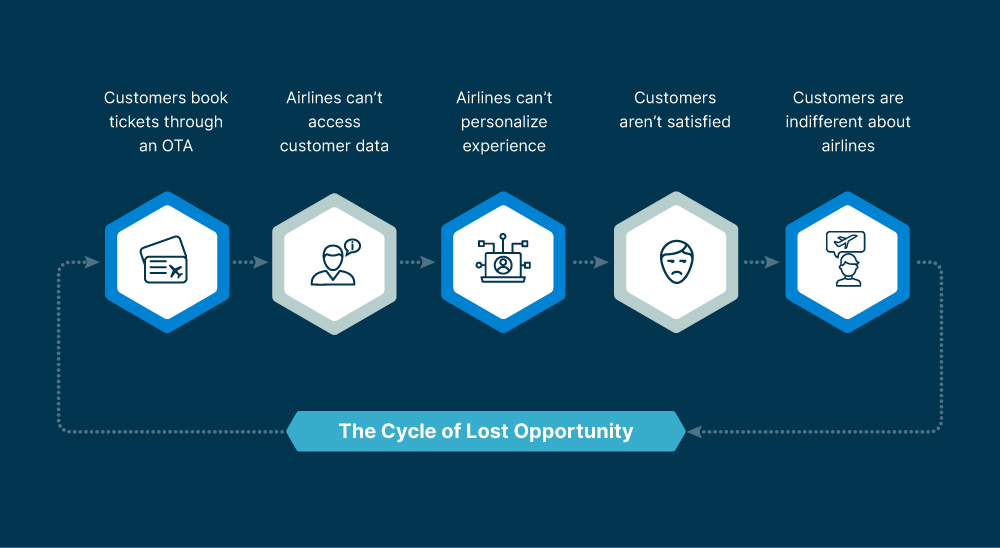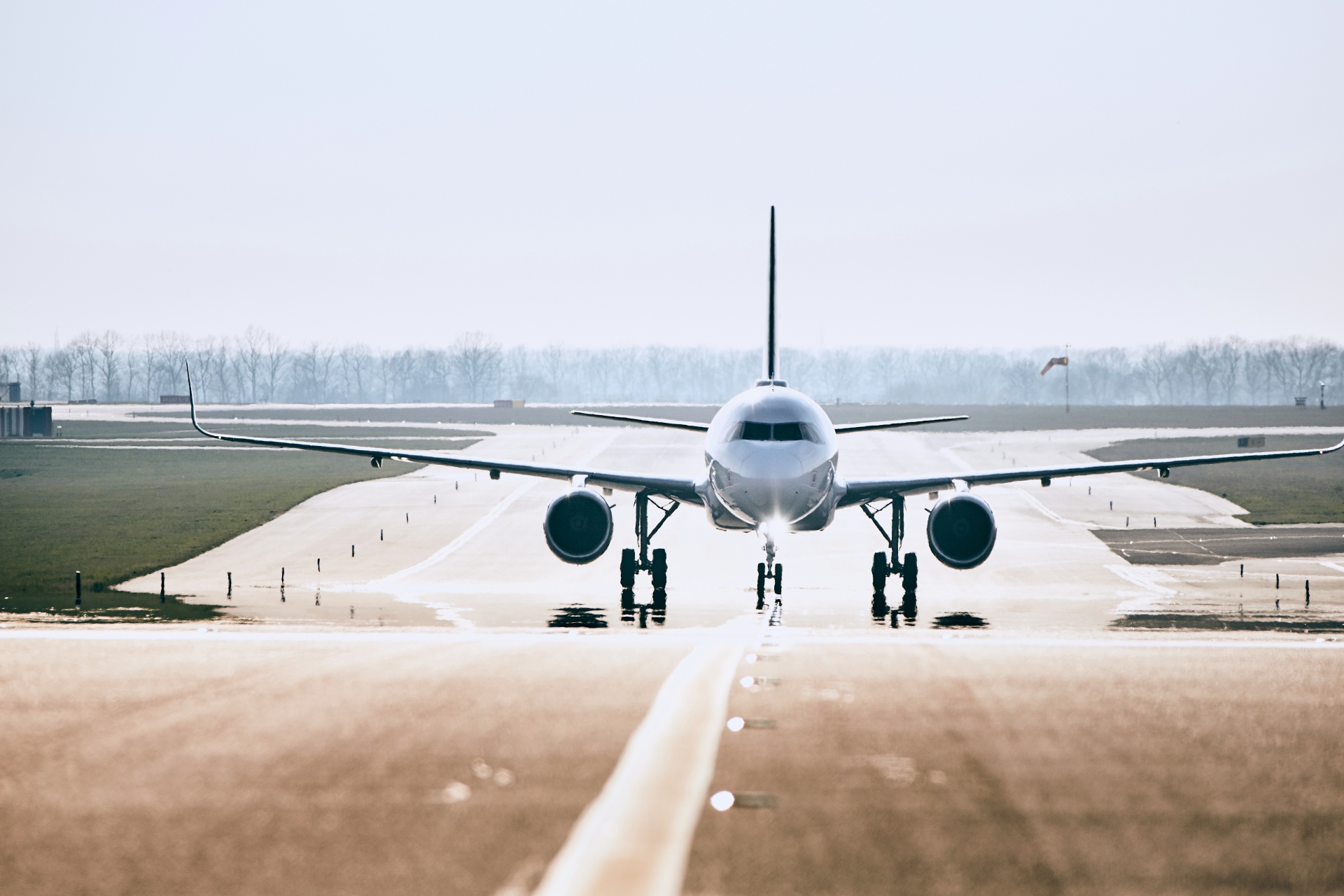Digital transformation process incurs difficulties for airlines to face with. Finding the right approach, the right tools and the right resources will ensure a transformation success.
“At least 40% of all businesses will die in the next 10 years if they don’t figure out how to change their entire company to accommodate new technologies” – John Chambers, Executive Chairman, Cisco System.
With 4 billion passengers transported using air travel over a global network of some 22,000 routes and a global collective net profit of $30 billion in 2018, the International Air Transport Association (IATA) continues to share a positive outlook of the industry.(1)
While the airline industry is seemingly doing so well altogether, the sustainability of its growth is being questioned as a result of high fuel and labor costs, ever-increasing taxation and demanding customers. At the same time, despite the decelerating growth rate of customer demand in 2019 compared to the previous years (Figure 1), over the next two decades, the demand for air transport is estimated by IATA to double.(1)

To successfully meet the demands while staying profitable, the industry must transform and excel, both individually and as a whole. Understanding that, airlines are rushing to technology – the only way they know that can help them fulfill customer needs. Despite all the buzz digital transformation is receiving, airlines are still struggling to renovate themselves as digital transformation is not ready-to-wear, it’s made-to-measure. There are challenges along the way to digitize but there are also solutions, both of which will be untangled below.:
Why is it so hard to transform?
Compared to other markets such as retail or fashion, airlines are relatively new to the digital transformation game but they are well-aware that they need to transform themselves. It’s now or never. Yet, despite more than three-quarters of the major airlines have started this process, barely a third could be considered successful1. This is perhaps, not that surprising given the industry’s highly regulated nature, safety awareness, functional silos and the high costs for digital initiative implementation. So looking closer, the main challenges are as followed:
Scarce digital talents: Employees are the core competencies of every business and airlines are no exceptions. Airlines are typically relying on external digital consultants and experts to implement digital initiatives. Data shows that more than a third of airlines have hired a third-party to carry out digital projects(3). While this is a good start, the real struggle for airlines is to manage and maintain these initiatives both during and post-implementation. To do so, they need to have their own in-house digital experts including experienced data scientists, agile developers, and IT architects. Unfortunately, employees with these skillsets are difficult to attract and retain and airlines do not appear to be as exciting to work for as tech companies or start-ups.
Resistance to cultural change: The human nature is risk-averse and airlines, by the nature of their business, have an even stronger error-free mentality. To some extent, that is necessary, but this mindset is very different from the trial-and-error, fail-fast approach of digitization. Airline leaders admitted that the top barrier to digital transformation is internal organizations’ concern about changes to organizational structure or functions. By sticking will this mindset, airlines will be lagged behind competitors and customer expectations.
Gather insightful customer data: Customer data is now the new jet fuel. So part of the problem here is that we don’t know our customers very well. Unfortunately, most airlines are stuck in the ‘Cycle of Lost Opportunity’ (Figure 2): The majority of customers are infrequent flyers and they book their tickets through an online travel agent (OTA) or in a group. This makes it challenging for airlines to gather insightful data and as a result, they fail to understand their customer needs and fail to boost their relationship with passengers beyond the point of “Hello, welcome aboard” and “Thank you for flying with us”. This unremarkable flying experience doesn’t differentiate the airline from other competitor and hence, customers continue to book their tickets via a third party to get the cheapest price instead of booking directly with an airline and again, airlines continue to struggle to gather customer data.

Find the right balance between costs and value-added: According to a recent survey conducted by Statista, price remains the most important factor when customers are booking a flight(4). As a result, in an ever more competitive landscape, not only do low-cost carriers but also traditional airlines are operating with a tight low-cost operating model. However, low price is, in no means, the only factor affecting customer decision. Convenience comes at a close second. Finding the sweet spot of relatively low cost and high value-added is a real struggle for airlines. If transformation targets or value-added from digital initiatives are too low, they won’t spur employee engagement, provide necessary added value to customers or provoke the difficult trade-offs required for successful change. On the contrary, far-fetched digital initiatives will be costly and will create employee skepticism, soon, followed by a failing cost structure and a mass resignation.
The road to digital transformation is rocky but traversable
As stated, digital adoption is no simple game for airlines. However, with the right approach, the right tools and resources, success is achievable. For example, Air Asia has introduced facial recognition system FACES – Fast Airport Clearance Experience System for faster check-in and security process, as the name suggests. At the same time, Emirates is rolling out Meal Ordering Device for business class to ensure faster and more accurate service. From our comprehensive research and experience, the below lessons are the keys to success for airlines on the way to take off to digitization.
Answer the question Why: Everyone is transforming. Everyone is innovating. Everyone is saying they are using the latest technology to improve customer experience. It is easy to follow whatever other incumbents are doing. There are a million and one ways in which airlines could digitize from their check-in process to inflight experience to aircraft maintenance. However, only when the vision is clear that airlines could successfully transform themselves
Major airlines are more likely to prioritize operational efficiency due to the large scale that these airlines operate. Once they identify their goals, these airlines could start to reimagine how technology could help them optimize operations whether it is utilizing AI applications to predict the performance of aircraft and boost maintenance process or using VR to cut costs on cabin crew training. On the other hand, LCCs are most likely to apply digital transformation to increase their ancillary sales. This comes at no surprise given low-cost operators are largely dependent on ancillaries or additional services. Certain tools can help LCCs achieve this include data analytics, flexible payment methods or even inflight Internet connection that allows customers to research what they need before reaching their destination. One of the successors is Finnair who managed to redesign their mobile booking experience resulting in the conversion on the old mobile booking flow and ancillary sales are three times and eight times higher compared to the old booking journey, respectively.
In short, before embarking on a digital journey, airlines must know why they are transforming: is it to improve customer experience, optimize operations or to increase revenue.
Digital transformation must start from customers: This may sound cliché. Yes, we all know it. But are we doing it right? When we look at digital leaders across different industries: from Uber in transportation, Google in metasearch, Amazon in e-commerce to Airbnb in hospitality, Netflix in online streaming, they have one similar customer-centric approach. This approach is what sets them apart from their competitors. Amazon, for example, understands one of the main disadvantages of online shopping is that customers cannot bring their purchase home right away but wait for days before it can arrive at their front door. So they launched Amazon Prime to guarantee 2-day delivery, then they realized it wasn’t enough so they renovate their operations even further to provide Next-day delivery and most recently, 2-hour delivery for certain products in major cities.
Going back to the case of aviation, whatever we do, from data analytics to IoT, we do it to improve customer satisfaction, which we hope would turn into a high number of loyal customers. So we need to know who are our customers, what they value, what we can offer them to encourage them to book with us the next time. Airlines frequently misjudge the real needs of their customers. Business travelers, for example, are the major users of the mobile app, but most airlines don’t provide the specific requirements of these high-value customers—such as helping them to get out of airports quickly and making it easy to connect flights (Figure 3). Instead, airlines spend significant time and resources to develop low value features such as social media integration.

However, referring back to the ‘Gather insightful customer data’ challenge mentioned above, how can airlines break the ‘Cycle of Lost Opportunity’ to understand their customers better?
Partner with downward and upward players in the travel ecosystem: Airlines are not alone in the ecosystem. Before passengers board their flights, they could read about the destination for their holiday on a travel blog. They then buy airline tickets and, in many cases, book hotels through an OTA. After the flight, passengers could catch a taxi to their accommodation. To have a full understanding of customer behaviors and preferences, airlines need to have a close relationship with other players in the travel ecosystem to obtain data throughout the whole customer journey.
Ask the right questions: Passenger details site when booking a flight is a wonderful place for airlines to explore what they need to know about their passengers. Currently, on most OTA and airline websites, the only information they can get hold of are names, emails, phone numbers, passport numbers and their dietary requirements. These are simply not enough to build a full picture around the customer, no matter how many times they fly with the airline. Instead, airlines could include a few more questions, enough to gain more insights but not too many to annoy customers. Questions such as the purpose of their travel, the types of loyalty reward they would like to receive or their opinions on certain digital initiatives that directly affect them are likely to be both useful for airlines and pleasant for customers to answer.
Implement the right data analytics tools and resources: Data on its own is just data, data with the right tools and resources can become insights. Airlines need to build a large pool of digital experts and utilize the most suitable tools for their organization. Airlines might not successfully implement the right tools or have the right pool of skillsets the first time around but that isn’t unusual. Digital transformation does not happen overnight, it is a circle of understanding the current state of the organizations – identifying areas for improvements – selecting and implementing the best possible initiatives – continuously reviewing, evaluating and improving the solutions post-implementation. This takes us to the next lesson: Be patient and … Digitize.
Be patient and …. Digitize: When companies begin their digital journey, they tend to get excited and start various major digital initiatives all at the same time, expecting them to succeed fast. However, digital transformation is always accompanied by people transformation and IT transformation. This means to expect any sustainable success, companies must also upskill their employees, implement a digital culture and improve their IT capabilities. All of which are long-term journeys that we could hardly expect short-term outcomes. Moreover, digitization is never a one-time thing. The trial-error and fail-fast approach does not stop when when companies find the most suitable initiatives to implement, it’s a mindset that goes way beyond that point. FPT Digital Kaizen, for example, is an approach that allows the new mindset to be embedded into organization’s culture. It is a continuous approach where once you have implemented your digital initiatives, you continue to evaluate, provide feedback to continuously improve and update your initiatives or develop new ones to meet the business strategy.
Digital airlines – A vision ahead
Let’s imagine Ha enters the airline’s website and her common flying routes are already in display. She clicks on a route, chooses the date and all her personal details are pre-filled. She happily finishes the purchase in just a minute. During the flight to Japan, the new Frozen 2 movie that she has been wanting to see is featured on the screen in front of her because the airline knows that she loves Disney movies. After watching the movie, as Ha is flying to Japan, she starts the clearance and immigration process right at her seat with the embedded in-seat immigration systems including facial recognition and fingerprint identification. After the flight, Ha could accurately track where her luggage is, so she doesn’t need to wait around and eye on all suitcases on the belt. At the same time, thanks to IoT technologies, when the recline function of a seat does not perform up to standard, it automatically triggers an alert for repair.
All of these while sounds imaginative, are all possible. This is the future of airlines: efficient, seamless, technology-fueled processes. Despite various challenges ahead, airlines that use our lessons, are step-by-step taking off to digitization.
Reference sources
(1) IATA. 2019. Future of the Airline Industry 2035.
(2) Statista. 2019. Passenger airlines.
(3) PROS. 2019. The state of Airline Digitization: Expectations Meet Reality.
(4) Statista. 2019. Major considerations when booking a flight of airline travelers worldwide in 2019, by type of flight.
(5) Amadeus. 2017. Embracing Airline Digital Transformation: A spotlight on what travelers value.





